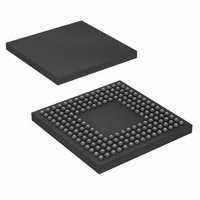AT91M55800A-33CJ Atmel, AT91M55800A-33CJ Datasheet - Page 99

AT91M55800A-33CJ
Manufacturer Part Number
AT91M55800A-33CJ
Description
IC ARM MCU 16BIT 176BGA
Manufacturer
Atmel
Series
AT91SAMr
Specifications of AT91M55800A-33CJ
Core Processor
ARM7
Core Size
16/32-Bit
Speed
33MHz
Connectivity
EBI/EMI, SPI, UART/USART
Peripherals
POR, WDT
Number Of I /o
58
Program Memory Type
ROMless
Ram Size
8K x 8
Voltage - Supply (vcc/vdd)
2.7 V ~ 3.6 V
Data Converters
A/D 8x10b; D/A 2x10b
Oscillator Type
Internal
Operating Temperature
-40°C ~ 85°C
Package / Case
176-LFBGA
Processor Series
AT91Mx
Core
ARM7TDMI
Data Bus Width
32 bit
Data Ram Size
8 KB
Interface Type
EBI, SPI, USART
Maximum Clock Frequency
33 MHz
Number Of Programmable I/os
58
Number Of Timers
10 bit
Operating Supply Voltage
3 V to 3.6 V
Maximum Operating Temperature
+ 85 C
Mounting Style
SMD/SMT
3rd Party Development Tools
JTRACE-ARM-2M, MDK-ARM, RL-ARM, ULINK2
Development Tools By Supplier
AT91EB55
Minimum Operating Temperature
- 40 C
On-chip Adc
10 bit, 8 Channel
On-chip Dac
8 bit, 2 Channel
Cpu Family
AT91
Device Core
ARM7TDMI
Device Core Size
32b
Frequency (max)
33MHz
Program Memory Size
Not Required
Total Internal Ram Size
8KB
# I/os (max)
58
Number Of Timers - General Purpose
6
Operating Supply Voltage (typ)
3.3V
Operating Supply Voltage (max)
3.6V
Operating Supply Voltage (min)
2.7V
Instruction Set Architecture
RISC
Operating Temp Range
-40C to 85C
Operating Temperature Classification
Industrial
Mounting
Surface Mount
Pin Count
176
Package Type
BGA
For Use With
AT91EB55 - KIT EVAL FOR ARM AT91M55800A
Lead Free Status / RoHS Status
Contains lead / RoHS non-compliant
Eeprom Size
-
Program Memory Size
-
Lead Free Status / Rohs Status
Lead free / RoHS Compliant
Available stocks
Company
Part Number
Manufacturer
Quantity
Price
Company:
Part Number:
AT91M55800A-33CJ
Manufacturer:
ATMEL
Quantity:
590
Part Number:
AT91M55800A-33CJ
Manufacturer:
ATMEL/爱特梅尔
Quantity:
20 000
Company:
Part Number:
AT91M55800A-33CJ SL383
Manufacturer:
Atmel
Quantity:
10 000
15.4
15.5
15.6
15.7
15.8
1745F–ATARM–06-Sep-07
Interrupt Masking
Interrupt Clearing and Setting
Fast Interrupt Request
Software Interrupt
Spurious Interrupt
Each interrupt source, including FIQ, can be enabled or disabled using the command registers
AIC_IECR and AIC_IDCR. The interrupt mask can be read in the Read-only register AIC_IMR. A
disabled interrupt does not affect the servicing of other interrupts.
All interrupt sources which are programmed to be edge-triggered (including FIQ) can be individ-
ually set or cleared by respectively writing to the registers AIC_ISCR and AIC_ICCR. This
function of the interrupt controller is available for auto-test or software debug purposes.
The external FIQ line is the only source which can raise a fast interrupt request to the processor.
Therefore, it has no priority controller.
The external FIQ line can be programmed to be positive or negative edge-triggered or high- or
low-level sensitive in the AIC_SMR0 register.
The fast interrupt handler address can be stored in the AIC_SVR0 register. The value written
into this register is available by reading the AIC_FVR register when an FIQ interrupt is raised. By
storing the following instruction at address 0x0000001C, the processor loads the program
counter with the interrupt handler address stored in the AIC_FVR register.
Alternatively, the interrupt handler can be stored starting from address 0x0000001C as
described in the ARM7TDMI datasheet.
Interrupt source 1 of the advanced interrupt controller is a software interrupt. It must be pro-
grammed to be edge-triggered in order to set or clear it by writing to the AIC_ISCR and
AIC_ICCR.
This is totally independent of the SWI instruction of the ARM7TDMI processor.
When the AIC asserts the NIRQ line, the ARM7TDMI enters IRQ mode and the interrupt handler
reads the IVR. It may happen that the AIC de-asserts the NIRQ line after the core has taken into
account the NIRQ assertion and before the read of the IVR.
This behavior is called a Spurious Interrupt.
The AIC is able to detect these Spurious Interrupts and returns the Spurious Vector when the
IVR is read. The Spurious Vector can be programmed by the user when the vector table is
initialized.
A Spurious Interrupt may occur in the following cases:
• With any sources programmed to be level sensitive, if the interrupt signal of the AIC input is
• If an interrupt is asserted at the same time as the software is disabling the corresponding
de-asserted at the same time as it is taken into account by the ARM7TDMI.
source through AIC_IDCR (this can happen due to the pipelining of the ARM Core).
ldr PC,[PC,# -&F20]
AT91M5880A
99















